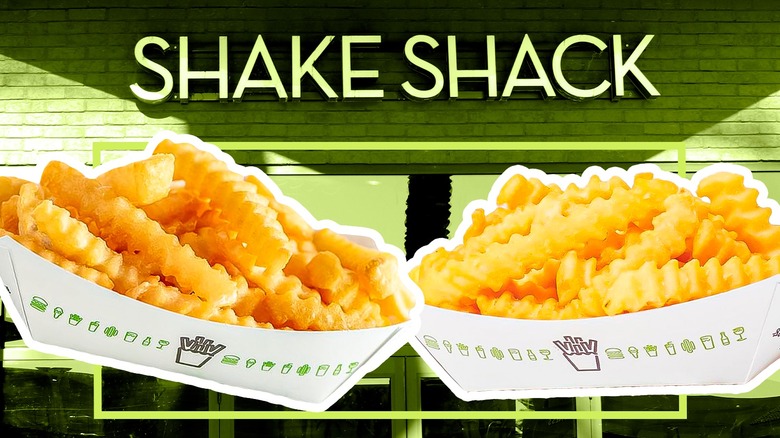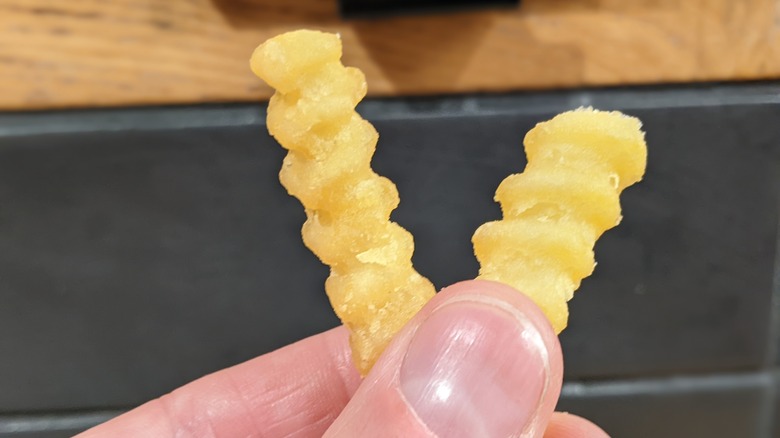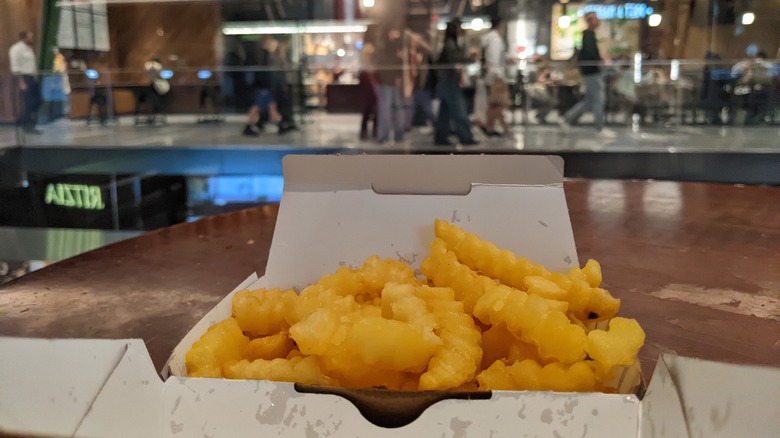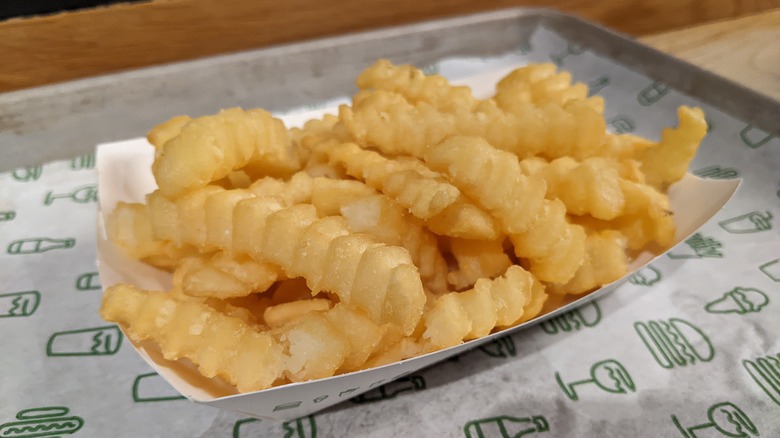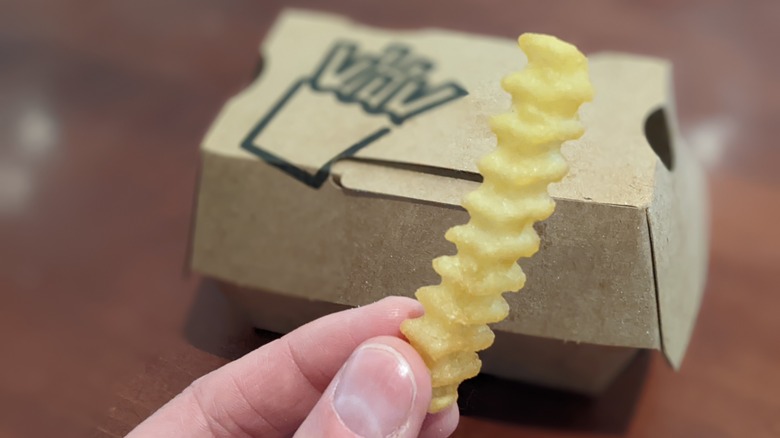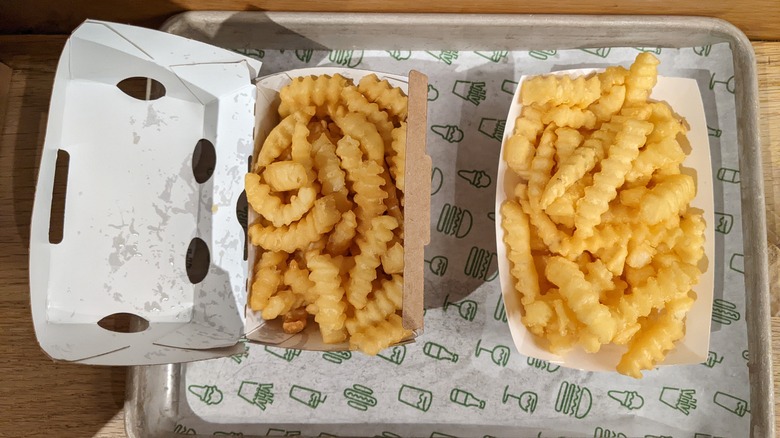We Tried The New Shake Shack Fries Cooked In Sugarcane Oil And It's A Game-Changer
Move over, soybean; there's a new oil in town. Shake Shack's quietly introduced a new type of frying oil to two locations in New York City. You won't see it advertised at the counter, but Zero Acre oil made from sugarcane is the secret ingredient in Shake Shack's fried foods ... but only if you're willing and able to travel to the extremely limited rollout.
While food developers may never give us a french fry safely in the realms of what we'd consider healthy, the industry's gotten really good at mitigating the worst effects of junk food while preserving the taste. The latest development in the game is sugarcane oil. For all the bad rap that processed sugar gets, it turns out the source for it can yield some really healthy fatty acids while also growing beautifully under conditions other plants can't ... and without requiring additional resources.
To see if it really makes a difference, we took a quick tour in succession of two Shake Shack spots in midtown Manhattan: the Penn Station location for the original flavor, and the new Shake Shack at Hudson Yards, where the frying oil is getting a test run.
What is Zero Acre oil?
Zero Acre oil is a brand of cooking oil made from sugarcane. The brand claims to be more sustainable owing to its use of rain rather than irrigation to grow its base crop, and also due to the cane's excellent oil yield compared to corn or soy: more product given for fewer resources consumed. But we don't have to choose, because sugarcane can grow in areas that would be useless to produce crops eaten by people and livestock, so that's neat.
Additionally, the oil obtained is better for human consumption. Zero Acre says its cane oil's high monounsaturated fat gives it an edge over the polyunsaturated fats found in vegetable oils, as the former is more stable under the high temperatures achieved in frying, and is healthier for the heart. There's even evidence that monounsaturated fats like olive oil and avocado oil are better for weight loss and reducing inflammation, or at least contributing to it less. With far less omega-6, sugarcane oil is an even more attractive version of those benefits.
At the time of publication, Shake Shack was unable to provide nutritional info on its fries cooked in Zero Acre oil, though we venture to say they'd compare at least somewhat favorably to Shake Shack's regular fries. Those, ungarnished, have 470 calories and 22 grams of fat, of which 4.5 are saturated fat. They contain 63 grams of carbohydrates, with only 1 gram being sugar, and a surprising 6 grams of protein.
Where are the Zero Acre oil fries available?
Shake Shack's test run of Zero Acre oil is exclusively at two locations in Manhattan: the Hudson Yards spot in the new development's luxury mall, and all the way downtown at Battery Park. Normally the burger spot uses soybean oil to fry its foods, and that will remain the case for nearly all Shake Shack locations during this trial. Sorry to tell you that if you're not in the New York City area, you won't be able to try these fries unless they're a smashing success and Zero Acre becomes the new Shake Shack standard oil.
As there's only one type of cooking oil in the fryer, it seems that Shake Shack is also using Zero Acre in any menu item with a fried element: the deep-fried 'Shroom Burger and its Shack Stack final form, the Veggie Stack, Chicken Shack, Chicken Bites, and the current Hot Menu, which includes Spicy Fries and the fourth iteration of the chain's frequent limited time-offering Hot Chicken. However, these menu items all have additional ingredients that would make it difficult to discern any differences between the two versions. To keep our comparison pure, it would have to be fry-focused. So we scarfed two orders of french fries — no ketchup or other toppings, like some kind of savage would — in the name of science.
Taste test: Shake Shack's original fries made with soybean oil
Ah, the crinkle-cut: middle child of the french fry world. With its extra surface area, it ought to be many people's favorite for its bonus crispiness and ability to pull more condiment without dropping it, but it seems to be relegated to fourth place in so many rankings. Perhaps it's branding, as most places that employ crinkle-cut fries seem to consider them an afterthought: a steamed, limp tray to catch some toppings rather than a vehicle for a light condiment. Shake Shack always puts the effort into elevating these to their crispy optimum, but even so, most of its fry offerings seem to map out to "Fries plus whatever limited-time sauce or seasoning is rolling through here."
All of which is to say that Shake Shack's fast-food burger that tastes gourmet was a revelation that quickly led to a global expansion. But the crinkle-cut fries, though cooked to the form's ideal state, never changed the game — and we say that as avowed fans of their many iterations, particularly those on the restaurant's white truffle menu. Shack fry iterations are always good, but have never quite reached a peak exclamation of "You've got to get the fries when you're there."
Tried next to the new Zero Acre, there's a mild plantiness to the finish that recalls Impossible Burger: none too surprising, considering both are soy-based. It's not an unpleasant note at all, but it's a definite presence when you have something else to compare it to.
Taste test: Shake Shack's Zero Acre oil fries
Zero Acre says its oil is neutral, but it's possible to detect creaminess here similar to coconut oil. In our opinion, that's a good thing, but if the official takeaway is that it starts off neutral and stays as such even after withstanding high-heat cooking (its smoke point is 485 F), we'll have to disagree that as it cools, a mildly coconut-like thickening occurs. Tough luck, scientists, but here's the good news: it is absolutely delightful.
The Zero Acre fries have a bit more body than they do at other locations, though it's least notable as they're still hot and steaming. We're sure that careful testing rolled out the perfect way to change the back end without dramatically altering the product, so it's interesting that the one notable change is an extended arc on the best part of a sizzling, gelatinized starch. Shake Shack, perhaps inadvertently, gave its fries a longer tail to enjoy them even if you have a long trip home or your delivery driver is lost.
We'd be very eager to compare this frying oil with Shake Shack's other menu items. Maybe it's time the Shack took its lightly pickled crispy onion concept to its natural conclusion with some long-overdue onion rings on the permanent menu.
Which is better, original Shake Shack fries or Zero Acre oil?
For our money, it's the Zero Acre oil all the way. While both fries look the same and present a very neutral and similar profile in terms of crispiness and flavor, there's slightly less of an acidic tang to the Zero Acre backend. Additionally, as noted above, these are the rare fries that hold onto their quality as they cool. You know how McDonald's fries get that strange sour note as they reach room temperature? Not only is that notably absent in the Zero Acre edition, it's even a noticeable difference between the cooled fry and a piping-hot original edition fry served next to it. When your past-peak heat fry is more snackable than the version fresh out of the fryer, you know you've got a winner. People who eat fries slowly, your new king is crowned.
Add in that, perhaps unknown but never unexpectedly, producing vegetable oils is apparently pretty bad for the ecosystem, and there's a clear advantage to Zero Acre even if the two products were completely identical. While they're 95% alike, the differences are all advantage: Zero Acre.
Really, we'd love to see this become the new standard at Shake Shack. With its environmental, health, and taste benefits, it's a no-brainer. And perhaps most of all, Shake Shack might finally have twigged upon the adjustment that makes its fries a game-changer the way its burgers have always been.
